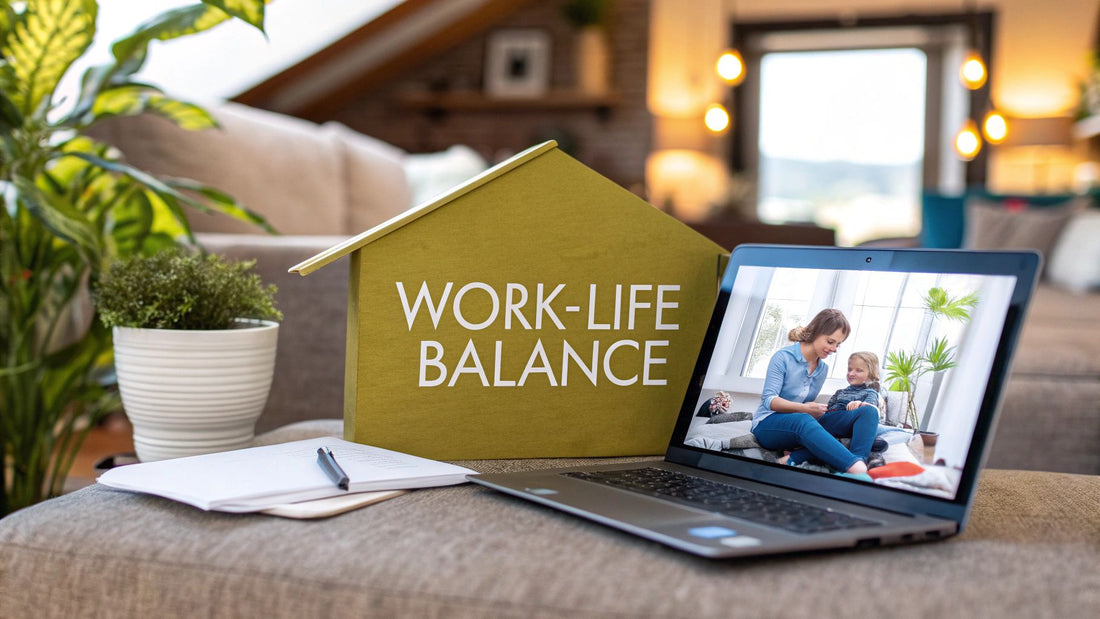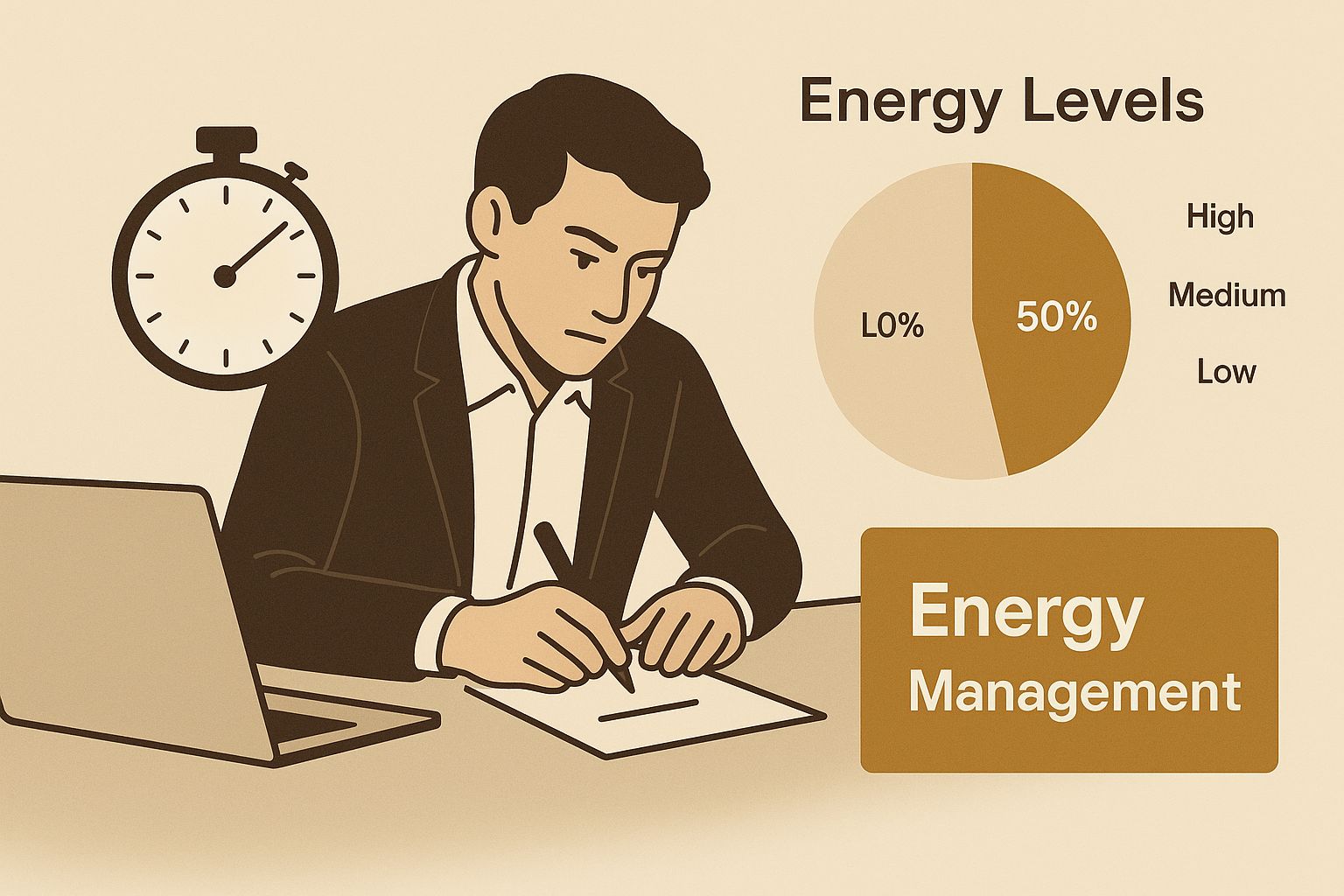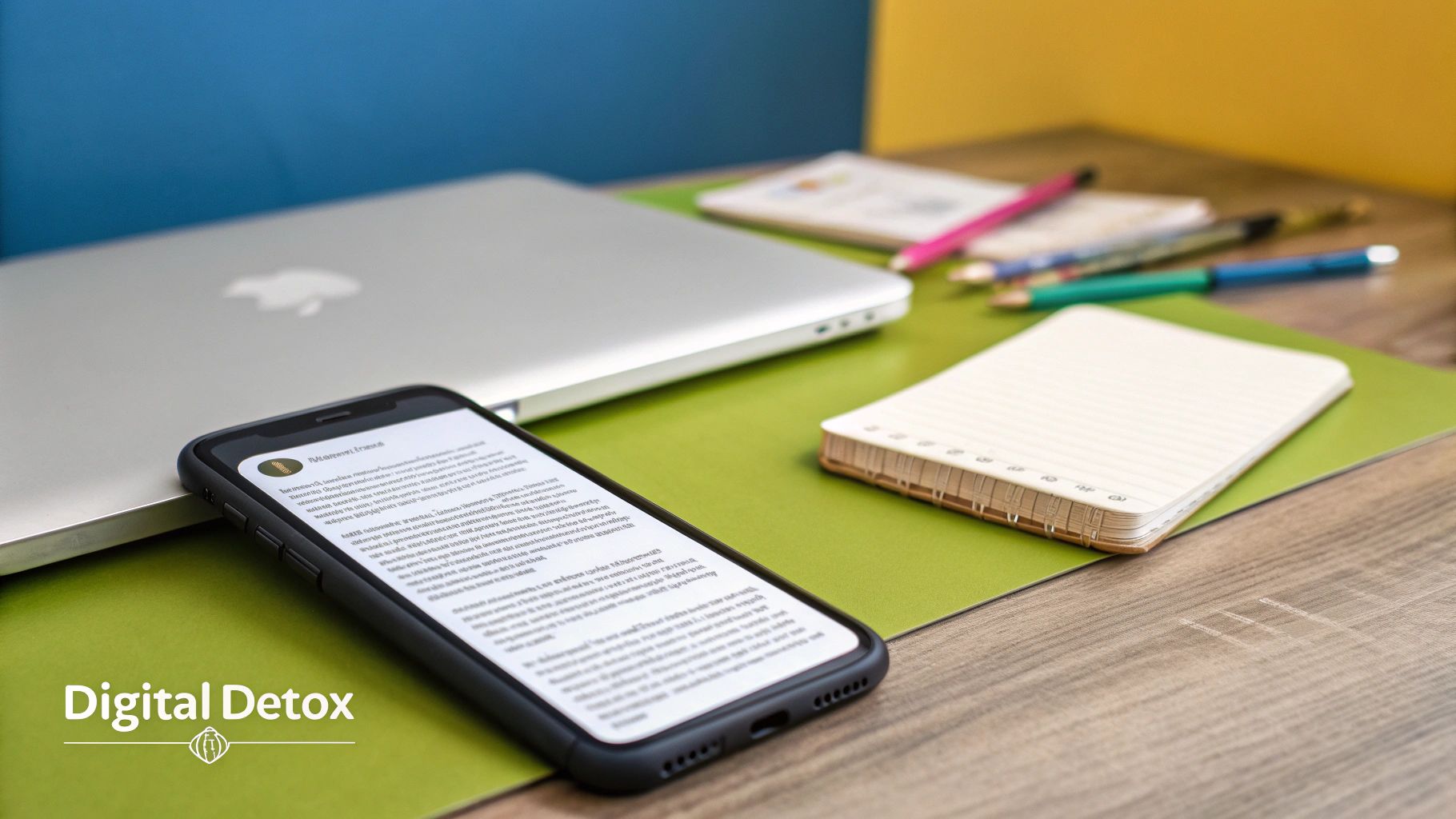
How to Maintain Work Life Balance Before Burnout Strikes
Share
So, how do you actually maintain a healthy work-life balance? Stop chasing the impossible 50/50 split between your desk and your personal life. The secret is to build a smarter system—one based on intentional boundaries, strategic energy management, and the ability to mindfully disconnect.
This isn't about theory; it's about feeling in control and present, whether you're in a meeting or at the dinner table. This guide gives you the exact strategies to build a thriving career without sacrificing your well-being. Stop waiting for burnout to force a change—start now.
Why "Work-Life Balance" Is a Myth
Let’s get one thing straight: the idea of a perfectly balanced scale between work and life is a fantasy. Chasing an equal number of hours for each is a fast track to feeling like you're failing at both.
The real goal isn't perfect equilibrium. It's about creating a sustainable integration where you feel fulfilled, not just constantly busy. It's about having enough energy for your career and for the moments that truly matter outside of it.
This shift in perspective is everything. When you stop chasing a myth, you can start building a realistic, resilient lifestyle. The focus moves from counting hours to intentionally managing where your energy and attention go. Don't let burnout sneak up on you; implement these proactive strategies to avoid burnout and take back control of your energy today.
Redefining Success Beyond Hours Worked
Our culture loves to glorify long hours as a badge of honor, but the data tells a very different story. Sometimes, working less is the clearest sign of a healthy work-life integration.
Just look at the OECD data. Italy scores an impressive 9.4 out of 10 on its work-life balance index. A huge reason why is that only 3% of Italian employees work excessively long hours. That’s a massive difference from the 10% average across other developed nations.
The ultimate goal isn't to achieve a perfect, static balance. It's to create a dynamic, flexible system that allows you to be fully present and effective wherever you are—whether that's leading a meeting or enjoying dinner with your family.
This guide will walk you through the four pillars of building this sustainable model. It's a quick overview of the core strategies this guide covers, showing you the actionable steps to regain control.
The Four Pillars of Sustainable Work-Life Balance
| Pillar | Key Action | Primary Benefit |
|---|---|---|
| Intentional Boundaries | Create firm, respected limits on your time and availability. | Protects your personal time and prevents work from creeping into every hour of the day. |
| Strategic Energy Management | Align your tasks with your natural energy cycles. | Maximizes productivity during work hours and minimizes exhaustion afterward. |
| Mindful Disconnection | Master the art of mentally "signing off" from work. | Allows for genuine rest and recovery, which is crucial for preventing burnout. |
| Integrated Self-Care | Weave wellness practices into your daily workflow. | Ensures self-care isn't an afterthought but a consistent part of your routine. |
By focusing on these four areas, you're not just managing your time better—you're fundamentally changing your relationship with work. You’re building a life that feels both productive and deeply satisfying.
Setting Boundaries That Actually Stick
Let’s be honest, the whole idea of "saying no" sounds great on paper, but in the moment, it can feel impossible. But effective boundaries aren't about building walls. They’re about creating a clear framework that tells people how you work best and protects your two most precious resources—your time and your energy.
This isn't just a personal preference anymore; it's a critical cultural shift.
Younger generations are leading the charge. A recent Deloitte Global Gen Z and Millennial Survey found that work-life balance is a bigger deal to them than climbing the corporate ladder. With only 6% of Gen Z even aiming for a top leadership role, it's clear the focus has shifted from "hustle culture" to building a life that actually feels good.
So, setting firm boundaries is no longer a sign of weak ambition. It's a smart, strategic move for long-term success and sanity.

Create Your Hard Stops
A "hard stop" is your non-negotiable end to the workday. It's that moment you officially clock out and switch from professional-you to personal-you. For it to work, you—and your team—have to respect it. Take action today: block off your calendar after 5:30 PM and set up an auto-reply that says, "Thanks for your message! I'm offline for the day to recharge and will get back to you during business hours tomorrow. If this is truly urgent, please contact [X]."
That simple action does two powerful things at once: it fiercely protects your personal time and, just as importantly, it models healthy behavior for the entire team.
Protect Your Focus During Work Hours
Boundaries aren't just for after 5 PM; they are absolutely critical during your workday. Guarding your focus is the secret to getting things done and a huge part of maintaining a healthy work-life balance.
Implement these powerful tactics immediately:
- Time Block: Open your calendar right now and block out chunks of time for deep work. Label it "Do Not Disturb - Project Focus." This keeps meetings from creeping in and signals your unavailability.
- Master Your Status: Your Slack or Teams status is a powerful tool. Use it! A simple "Heads down until 2 PM" can deflect dozens of "quick question" pings that derail your flow.
- End-of-Day Rituals: Even working from home, you need to signal that the day is over. Changing out of your work clothes is a powerful mental trigger. Making this transition feel incredible is key. Elevate your evening ritual now with our collection of stylish work from home outfits designed for immediate relaxation.
Think of it this way: setting boundaries isn’t about restricting access to you. It’s about directing people to the best version of you. By defining when and how you're available, you make sure that when you are working, you're 100% present, focused, and effective.
Manage Your Energy, Not Just Your Time
Staring at an endless to-do list is a one-way ticket to burnout. It’s time you stopped obsessing over the clock and started managing your energy. That's the real currency of productivity and the secret sauce to actually learning how to maintain work life balance.
Think of your energy like a battery. Some tasks drain it in minutes, while others barely make a dent. The trick is to match your toughest work with your peak energy levels. Are you sharpest at 8 AM? That’s prime time for your complex strategic plan. Hit a creative high after lunch? Block that time for brainstorming. This simple change will massively boost your output without adding a single extra minute to your day.
This isn't about working longer; it's about working smarter. When you sync your professional demands with your natural human rhythms, you set yourself up for better performance and a much healthier state of mind.
This visual shows how a diligent professional uses energy management, not just a timer, to stay productive.

The big takeaway here? True efficiency comes from fiercely protecting your focus and energy. They’re finite resources—treat them that way.
The shift from just managing time to managing energy is a game-changer. Let's look at how these two approaches stack up.
Time Management vs Energy Management: A Comparison
| Aspect | Traditional Time Management | Modern Energy Management |
|---|---|---|
| Primary Focus | Fitting more tasks into the day | Doing the right tasks at the right time |
| Core Metric | Hours worked | Quality of output |
| Scheduling Basis | Calendar availability and deadlines | Personal energy cycles (highs and lows) |
| Approach to Breaks | Breaks are for when you're done | Breaks are strategic and restorative |
| End Goal | Completing the to-do list | Sustainable high performance and well-being |
As you can see, energy management isn't just a new buzzword—it's a more strategic and human-centric way to approach your work life.
Defend Your Focus with Time Blocking
So, how do you put this into practice? Time blocking is your best defense against a schedule that feels like it's been put in a blender. Instead of reacting to whatever comes your way, you proactively tell your time where to go. You assign a specific job to every part of your day.
This means scheduling blocks not just for meetings, but for deep, focused work, clearing your inbox, and—yes—taking actual breaks.
For instance, a project manager could block off their calendar like this:
- 9:00–11:00 AM: Deep Work: Q3 Budget Analysis (Phone on silent, notifications off)
- 2:00–2:30 PM: Client Call Follow-Ups (Focused communication time)
This structure is amazing because it minimizes context-switching, that mental whiplash from jumping between tasks that absolutely kills productivity and drains your energy. It creates clear boundaries that protect your most valuable asset: your attention.
By treating your time like a finite inventory and allocating it with purpose, you shift from being reactive to being in control. This isn't just time management; it's a powerful strategy for preserving your mental energy for the tasks that matter most.
When you start thinking "energy first," your calendar stops being a list of obligations and becomes a strategic tool for peak performance and well-being. It’s a complete game-changer.
Winning the War Against Digital Distractions
Let's be honest, your biggest obstacle to a healthy work-life balance is buzzing in your pocket right now. This "always-on" culture is a one-way ticket to burnout. That constant stream of notifications makes it feel impossible to ever truly sign off.
Learning to reclaim your personal time from technology isn't just a nice idea—it's a critical act of self-preservation you must start today.
This digital creep is a huge reason why global employee engagement has plummeted to just 21%. When the lines between your work life and home life get blurry, it's incredibly difficult to feel supported or engaged. Deloitte's workplace trend reports show that managers, ironically, saw the sharpest drop in engagement, which just goes to show how vital it is for leaders to model healthy digital boundaries.

Create Your Digital Sunset
Think of a "digital sunset" as your personal, non-negotiable ritual for unplugging from work tech. It’s a clear signal to your brain that the workday is officially done. Without this deliberate separation, you're stuck in a partial work-mode all evening long.
Here’s your action plan for tonight:
- Pick a hard stop time. Decide on a specific time, say 6:00 PM, when all work devices get put away. No exceptions.
- Silence the noise. Go into your phone settings right now and turn off notifications for email, Slack, and Teams after hours.
- Set the expectation. Let your team know you'll be offline and unreachable. A simple status update can work wonders.
That little voice telling you to check your email "one last time" is powerful. But every time you resist, you're building the discipline needed to protect your personal time and mental energy.
To finally tame your inbox for good, the Inbox Zero Method offers urgent strategies for taking back control.
And don't just log off—transform your space into a true sanctuary. Our guide on cozy home decor ideas is packed with quick wins to create a restful atmosphere that helps you unwind the moment you disconnect. This simple act reinforces that mental wall between your professional world and your personal space.
Build Self-Care Into Your Workflow
Let’s get one thing straight: self-care isn't a prize you get after a brutal week. It's the fuel that keeps you running. When you start treating exercise, hobbies, and sleep as essential parts of your professional toolkit, everything changes.
This means seeing these activities not as "time off," but as strategic investments in your focus and resilience. Schedule a midday walk with the same commitment you'd give a client call. Block out 10 minutes between meetings just to breathe. These small, consistent deposits into your well-being pay off immediately, sharpening your decisions and helping you handle whatever the day throws at you.
Weave Wellness Into Your Daily Rhythm
You don't need a massive life overhaul to bring more self-care into your day. It’s about building small, powerful habits that slide right into your existing schedule. Think of it as micro-dosing wellness.
A top executive credits her success not to logging more hours, but to a strict routine. For her, that’s a non-negotiable morning workout and, crucially, changing into something comfy the second her workday ends. That simple act creates a mental boundary, signaling her brain that it's time to power down and recharge.
You can take this idea and run with it. Don't wait for your energy to crash. Make the transition from "work mode" to "relax mode" feel incredible tonight with our unbelievably comfy work from home clothes.
Self-care is the most effective productivity strategy you're not using yet. When you prioritize your well-being, you're not just resting—you're preparing yourself to operate at your highest potential.
This isn’t just a hunch; it’s a strategy that’s working on a global scale. The Global Life-Work Balance Index shows how countries that build well-being into their culture thrive. New Zealand leads the pack with a score of 86.59, offering things like 32 days of annual leave.
It's proof that a culture of care drives success. These small, consistent acts of self-care are your secret weapon for a long, sustainable career.
Got Questions About Work-Life Balance? We've Got Answers.
Knowing the theory of work-life balance is one thing, but putting it into practice? That's a whole different ball game, especially when you're juggling a demanding boss or the feeling that you need to be “on” 24/7.
Let's get into the nitty-gritty and tackle some of the most common struggles with real-world, practical advice you can use today.
What If My Boss Expects Me to Be Available After Hours?
This is a classic—and tricky—situation. The secret isn't to ignore messages and hope for the best. It's about getting ahead of the problem by managing expectations before they manage you.
The best way to do this is with a calm, direct conversation. Try saying this: "I am 100% committed to giving my all during work hours. To stay that focused and productive, I need my evenings to fully disconnect. I will always ensure critical tasks are handled before I log off for the day."
This approach completely reframes the conversation. It's not about refusing to work; it's about setting yourself up to be a more effective, high-performing employee.
Setting boundaries isn't about being difficult. It's about being a sustainable professional. You're teaching people how to get the best work from you, and that’s a win for everyone.
How Can I Possibly Disconnect When I Work From Home?
When your office is three steps from your couch, the workday can feel like it never truly ends. The key is to create a powerful "end-of-day" ritual that sends a clear signal to your brain: work is over.
Do this tonight. These simple habits will make a huge difference:
- The Big Shutdown: Don't just close your laptop. Close all tabs, quit the apps, and physically put your computer away. If it's out of sight, it's out of mind.
- The Five-Minute Transition: Immediately after shutting down, do something to break the mental tie to work. Go for a quick 15-minute walk, change out of your "work" clothes, or fire up a specific "after-work" playlist.
You're creating a buffer zone—a small but mighty separation between your professional self and your personal self. It's this simple act that keeps your entire evening from feeling like you're just waiting for the next work email to land.
Finding true balance isn't a one-and-done goal; it's a daily practice of protecting your time and energy. Here at TeddyPaws, we believe real comfort is a huge part of that equation.
Slipping into our ultra-soft homewear is the perfect end-of-day ritual to help you melt away the stress and fully embrace your "me time." Don't wait until you're completely drained to start prioritizing rest. Give yourself the gift of total relaxation. Wrap yourself in a cloud-like hug tonight by visiting https://teddypaws.co.










